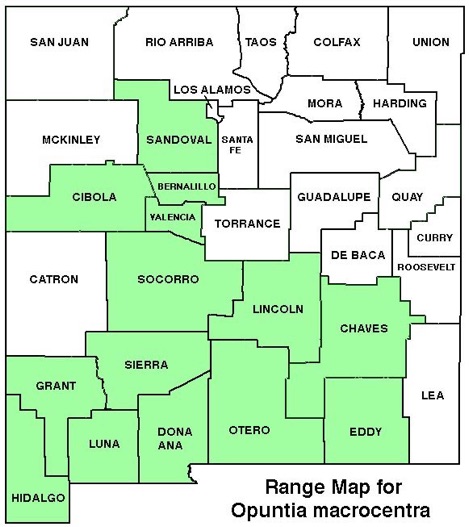WILDFLOWERS OF NEW MEXICO

Unlike most prickly pears, the pads of this cactus, normally bluish to gray-green, turn reddish-green to purple when stressed by cold or drought. The 2–3-feet tall, upright plant has smooth, oval to rounded pads 4–8-inches (10–20 cm) long and wide. Note the yellow flowers have red centers, and the long spines are dark red to black.
SPINES: Areoles on the upper 1/4–1/2 of the pad, or sometimes only the upper edge, are 5/8–1 1/8-inches (15–30 mm) apart and armed with 0–15 reddish to brown to black spines, 1–4 3/4-inches long (2.5–12 cm), sometimes with yellow or white tips. Forms without spines or spines only along the pad apex occur. Areoles, especially upper ones, have thick bundles of brown glochids–wicked, barbed, hair-like bristles easily detached if touched and painful and difficult to remove.
FLOWER: March–June. The showy flowers, 2 1/4–3-inches wide (5.5–8 cm) have yellow petal-like tepals with bright red bases that taper upward to a point in the center of the tepal. The stigma lobes are cream to light green. Barrel-shaped fruits mature red to purple, 1 1/4–1 3/4-inches long (3–4.3 cm), 1-inch (1.5–3 cm) in diameter, fleshy, and with rows of glochids but no spines.
HABITAT: Rocky, sandy soils; desert grasslands and scrub, pinyon-juniper-oak woodlands.
ELEVATION: 3,500-6,800 feet.
RANGE: AZ, NM, TX.
SIMILAR SPECIES: Periodic reorganization of this variable complex within Opuntia shuffle the virtually identical species and varieties like a deck of cards. Some authorities have combined several varieties as Purple Prickly Pear, O. azurea. The variable Brown-spined Prickly Pear, O. phaeacantha, which occasionally turns red when stressed, has shorter spines, 1 1/8–3 1/8-inches long (3–8 cm).
NM COUNTIES: Southern half of NM in low- to mid-elevation, arid habitats: Bernalillo, Chaves, Cibola, Dona Ana, Eddy, Grant, Hidalgo, Lincoln, Luna, Otero, Sandoval, Sierra, Socorro, Valencia.









LONG-SPINE PURPLE PRICKLY PEAR CACTUS
OPUNTIA MACROCENTRA (OPUNTIA VIOLACEA)
Cactus Family, Cactaceae
Perennial cactus









THE CONTENTS OF THIS WEBSITE ARE COPYRIGHTED AND CANNOT BE USED
WITHOUT PERMISSION OF GEORGE OXFORD MILLER
















































































Pads are oval to round. Some forms only have long spines only along the apex of the pad.
Pads turn red to purple when stressed by drought or cold temperatures.
Barrel-shaped, fleshy fruit have areoles with glochids but no spines.








EMAIL ME







